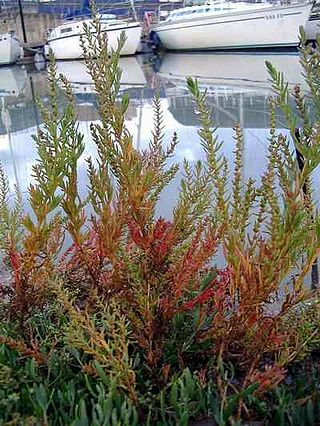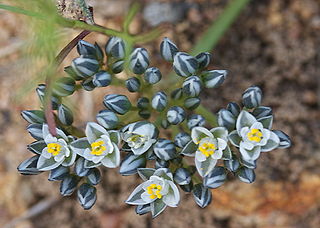
Amaranthaceae is a family of flowering plants commonly known as the amaranth family, in reference to its type genus Amaranthus. It includes the former goosefoot family Chenopodiaceae and contains about 165 genera and 2,040 species, making it the most species-rich lineage within its parent order, Caryophyllales.

Alternanthera is a genus of flowering plants in the family Amaranthaceae. It is a widespread genus with most species occurring in the tropical Americas, and others in Asia, Africa, and Australia. Plants of the genus may be known generally as joyweeds, or Joseph's coat. Several species are notorious noxious weeds.

The Gomphrenoideae are a subfamily of the Amaranthaceae.

The Amaranthoideae are a subfamily of the Amaranthaceae. The stamens have anthers with two lobes (locules) and four pollen sacs. The main distribution of the subfamily is in tropical America, in tropical and Southern Africa, and in Australia.

Iresine is a genus of flowering plants in the family Amaranthaceae. It contains 20 to 25 species, all of which are native to the American tropics. The generic name is derived from the Greek word εριος (erios), meaning "wooly", referring to the trichome-covered flowers. Bloodleaf is a common name for those species that have colored foliage, and these are often cultivated as ornamental plants. Some species are additives to versions of the hallucinogenic drink ayahuasca.

Cleome is a genus of flowering plants in the family Cleomaceae, commonly known as spider flowers, spider plants, spider weeds, or bee plants. Previously, it had been placed in the family Capparaceae, until DNA studies found the Cleomaceae genera to be more closely related to the Brassicaceae than the Capparaceae. Cleome and clammyweed can sometimes be confused.

Suaeda is a genus of plants also known as seepweeds and sea-blites. Most species are confined to saline or alkaline soil habitats, such as coastal salt-flats and tidal wetlands. Many species have thick, succulent leaves, a characteristic seen in various plant genera that thrive in salty habitats.

Cyanotis is a genus of mainly perennial plants in the family Commelinaceae, first described in 1825. It is native to Africa, southern Asia, and northern Australia.
Paraerva microphylla is a species of flowering plant in the family Amaranthaceae. It is a subshrub or shrub endemic to the islands of Socotra and Abd al Kuri in the Socotra archipelago off the coast of East Africa, which are politically part of Yemen.
Paraerva revoluta is a species of flowering plant in the family Amaranthaceae. It is a shrub endemic to the archipelago of Socotra, which is biogeographically part of East Africa and politically part of Yemen.

Ptilotus is a genus of approximately 120 species of annual and perennial herbs and shrubs in the family Amaranthaceae. All species are native to mainland Australia, although one species, Ptilotus spathulatus (R.Br.) Poir., also occurs in Tasmania and another, Ptilotus conicus R.Br., in Malesia on the islands of Flores and Timor. Most of the diversity is in Western Australia, particularly in the Pilbara. Common names for species in this genus include mulla mulla, foxtails, pussy tails and lamb's tails. The genus was first formally described by botanist Robert Brown in Prodromus Florae Novae Hollandiae in 1810. In family-level phylogenetic studies, Ptilotus has been placed within a clade informally known as the 'aervoids'. It has been resolved as monophyletic and is closely related to Aerva Forssk. An interactive key to the species of Ptilotus is available at KeyBase.

Aerva javanica, the kapok bush or desert cotton, is a species of plant in the family Amaranthaceae. It has a native distribution incorporating much of Africa, and the south-west and south of Asia, and it has become adventitious in northern Australia.

Ouret lanata, the mountain knotgrass, is a woody, prostrate or succulent, perennial herb in the family Amaranthaceae, native to the tropics of Africa and Asia. It has been included as occurring in Australia by the US government, but it is not recognised as occurring in Australia by any Australian state herbarium or Plants of the World Online. The plant sometimes flowers in the first year.

Limeum is a genus of flowering plants. It includes 25 species.

Caroxylon is a genus of shrubby flowering plants in the family Amaranthaceae, found in drier areas of the Old World, including southern Africa, Madagascar, northern Africa, Mediterranean islands of Europe, the Canary Islands, Socotra, Ukraine, Russia, western Asia, Central Asia, India, western and northern China, and Mongolia.
Wadithamnus artemisioides is a species of flowering plant belonging to the family Amaranthaceae. It is a subshrub or shrub native to Yemen and Oman in the southern Arabian Peninsula. It is the sole species in genus Wadithamnus.

Exomis is a genus of flowering plants belonging to the family Amaranthaceae. It just contains one species, Exomis microphylla(Thunb.) Aellen It is also in the Chenopodioideae subfamily.
Paraerva is a genus of flowering plants in family Amaranthaceae. It includes two species which are endemic to the Socotra archipelago.














